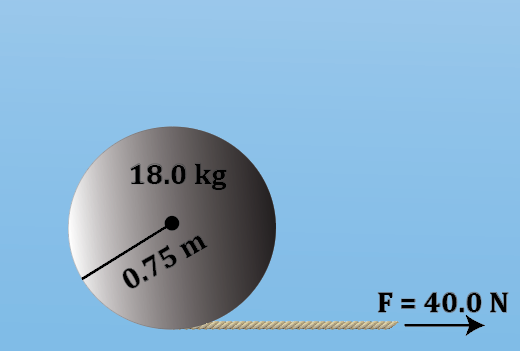- Download the worksheet to save time writing
- Start solving the practice problems
- If you're stuck, watch the video solutions
- See your summary to get more insights

Initially resting on a frictionless surface in a lab, a solid aluminum disk with a mass of 18.0 kg and radius 0.75 m is acted upon by a string wrapped around its rim. A steady horizontal force of 40.0 N is exerted on the string, which remains fixed on the rim without slipping. The string does not slip on the disk's rim. When the disk has moved a distance of 4.0 m, calculate the angular velocity of the disk (in radians per second). Use: acceleration of the center of mass = 2.22 m/s2.
You pull with your hand on a string wound around a cylinder of diameter 30 cm and weight 39 N. The cylinder is free to rotate around a horizontal axle passing through its center of mass. The 30 N applied force is directed toward the positive x-axis and pulls the string tangentially from the cylinder as shown in the image. Determine i) the magnitude and ii) the direction of the force that the axle exerts on the cylinder.

A steam engine has its flywheel pivoted about a vertical axle through its center. The flywheel has a moment of inertia of 2200 kg•m2, a radius of 1.80 m, and spins with insignificant friction. An engineer studying the flywheel applies a tangential 35.0 N force to the flywheel's circumference for 8.0 s. Determine the work done by the engineer on the flywheel it was at rest when the force was applied.
A 450 g globe (solid sphere) of radius 12.5 cm initially motionless revolves about its central vertical axis under the influence of a constant tangential and horizontal force of magnitude 1.25 N. The force is applied along the line around the middle of the globe. The angular speed of the globe 15 s after the application of the force is 36 rpm. Assume that there is a constant frictional force f between the globe and the axis of rotation. Calculate the torque produced by f.
A solid sphere is rolling on a horizontal surface with an initial speed of v = 4.5 m/s. When it encounters a ramp inclined at 25°, what distance will it ascend the incline before coming to a stop? (Assume no slipping occurs during the motion)
What is the required torque when the arm utilizing the triceps muscle accelerates a 3.7-kg object at 7.1 m/s²?
What is the acceleration of a solid sphere rubber weight resting on the train floor relative to the car if the train accelerates with an acceleration a, assuming the object rolls without slipping?
A robotics company tests a robotic arm's end effector, which has a rectangular frame with dimensions of 2.0 meters by 1.0 meter. Dummy masses of 550 kg are attached at the left corners and 1,200 kg at the right corners of this device. If the rotation axes are 0.50 meters from the respective edges, which axis will present more resistance to acceleration?


